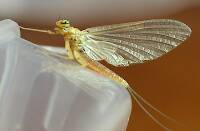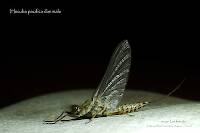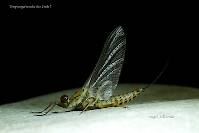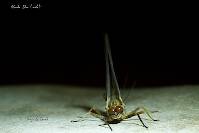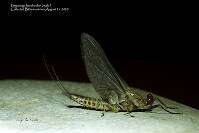
Hex Mayflies
Hexagenia limbata
The famous nocturnal Hex hatch of the Midwest (and a few other lucky locations) stirs to the surface mythically large brown trout that only touch streamers for the rest of the year.
Featured on the forum

This is an interesting one. Following the keys in Merritt R.W., Cummins, K.W., and Berg, M.B. (2019) and Jacobus et al. (2014), it keys clearly to Ephemerella. Jacobus et al provide a key to species, but some of the characteristics are tricky to interpret without illustrations. If I didn't make any mistakes, this one keys to Ephemerella mucronata, which has not previously been reported any closer to here than Montana and Alberta. The main character seems to fit well: "Abdominal terga with prominent, paired, subparallel, spiculate ridges." Several illustrations or descriptions of this holarctic species from the US and Europe seem to match, including the body length, tarsal claws and denticles, labial palp, and gill shapes. These sources include including Richard Allen's original description of this species in North America under the now-defunct name E. moffatae in Allen RK (1977) and the figures in this description of the species in Italy.

Troutnut is a project started in 2003 by salmonid ecologist Jason "Troutnut" Neuswanger to help anglers and
fly tyers unabashedly embrace the entomological side of the sport. Learn more about Troutnut or
support the project for an enhanced experience here.
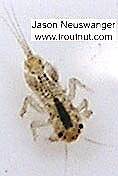
This nymph is an extremely early instar.
Warren on Apr 12, 2007April 12th, 2007, 8:30 am EDT
thats about a size 32 right. i dont think i have any tippet that small
warren
Troutnut on Apr 12, 2007April 12th, 2007, 9:39 am EDT
Hehe, that's a good bit smaller than a 32. I think you'll only need to imitate something this small when nymphing if you're "nymphing" for nymphs in the same sense that you could be "fishing" for fish.
If you find a hook that small, you could also use it for the water mite hatch.
If you find a hook that small, you could also use it for the water mite hatch.
Jason Neuswanger, Ph.D.
Troutnut and salmonid ecologist
Troutnut and salmonid ecologist
Quillgordon on Apr 12, 2007April 12th, 2007, 1:34 pm EDT
Warren,
I believe Jason said it was an immature nymph, so it still had some growing to do! I would say tye it in a size #16.
Jason,
Thomas Ames labeled the 'chocolate dun' ..... Ephemerella needhami. @ bottom of 3rd. paragraph
ttp://www.thomasames.com/insects/article/wintercad/wintercad.htm
the little Chocolate Dun, Ephemerella needhami.
Ernest Schwiebert,Jr. has it in the family 'Baetidae'.
Is this still true today, or have they been re-classified?
John
I believe Jason said it was an immature nymph, so it still had some growing to do! I would say tye it in a size #16.
Jason,
Thomas Ames labeled the 'chocolate dun' ..... Ephemerella needhami. @ bottom of 3rd. paragraph
ttp://www.thomasames.com/insects/article/wintercad/wintercad.htm
the little Chocolate Dun, Ephemerella needhami.
Ernest Schwiebert,Jr. has it in the family 'Baetidae'.
Is this still true today, or have they been re-classified?
John
Flyfishing is a state of mind! .............. Q.g.
C/R........barbless
C/R........barbless
Troutnut on Apr 12, 2007April 12th, 2007, 2:45 pm EDT
Lots of things have been called "chocolate duns" by somebody at some point, including E. needhami. See my page on the Chocolate Dun common name for the whole list.
It seems like almost every mayfly was in the Baetidae at one point or another; at least the species which were first described long ago. Maybe one of the entomologists here can fill in the history on that, but I get the impression maybe all mayflies were considered to be in the Baetidae family sometime in the 1800s before they had been seriously studied.
Anyway, Eurylophella has been in the Ephemerellidae family for a long time, but that might not have been the case when Schwiebert was first writing.
It seems like almost every mayfly was in the Baetidae at one point or another; at least the species which were first described long ago. Maybe one of the entomologists here can fill in the history on that, but I get the impression maybe all mayflies were considered to be in the Baetidae family sometime in the 1800s before they had been seriously studied.
Anyway, Eurylophella has been in the Ephemerellidae family for a long time, but that might not have been the case when Schwiebert was first writing.
Jason Neuswanger, Ph.D.
Troutnut and salmonid ecologist
Troutnut and salmonid ecologist
Konchu on Apr 12, 2007April 12th, 2007, 3:30 pm EDT
Ephemerellidae was first recognized as a formal family in 1909. In 1935, it was recognized as a subfamily of the Baetidae. The group was again recognized as a family in 1954. People who put Eurylophella in Baetidae after '54 probably were using an old reference (The Biology of Mayflies. Needham, Traver & Hsu. 1935. Ithaca, NY: Comstock P) and had not kept current with the scattered papers associated with the science. I've seen recent field guides that still put Eurylophella and other "Ephemerellidae" in Baetidae. In the old system, Ephemeridae, Baetidae and Heptageniidae pretty much were it as far as families went. Alas, the days of olde...
Jason: If you wish to duplicate this to a new thread, please do so. The subject has drifted (pun intended) from hook sizes.
Jason: If you wish to duplicate this to a new thread, please do so. The subject has drifted (pun intended) from hook sizes.
GONZO on Apr 12, 2007April 12th, 2007, 6:33 pm EDT
If John is referring to Schwiebert's Matching the Hatch, it was written in 1955 (the year of my birth) and it does follow the Ephemeridae/Baetidae/Heptageniidae structure of a much simpler time.
John,
You'll get confused a lot by following that old book, but one thing that will help is to check Taxon's website. He has done taxonomic updates for many popular fly fishing entomologies. If he has one for MtH, you could probably print it out and keep it inside the book for reference. Trust me, that will save a lot of frustrating translation!
John,
You'll get confused a lot by following that old book, but one thing that will help is to check Taxon's website. He has done taxonomic updates for many popular fly fishing entomologies. If he has one for MtH, you could probably print it out and keep it inside the book for reference. Trust me, that will save a lot of frustrating translation!
Taxon on Apr 12, 2007April 12th, 2007, 9:41 pm EDT
Gonzo & John-
Unfortunately, I don't have taxonomic updates for Schwiebert's Matching The Hatch on my website, simply because I don't have that book. However I do have taxonomic updates for Schwiebert's Nymphs, which would likely include all (or most) of the taxa listed in MtH.
Unfortunately, I don't have taxonomic updates for Schwiebert's Matching The Hatch on my website, simply because I don't have that book. However I do have taxonomic updates for Schwiebert's Nymphs, which would likely include all (or most) of the taxa listed in MtH.
Quillgordon on Apr 13, 2007April 13th, 2007, 1:57 am EDT
If John is referring to Schwiebert's Matching the Hatch, it was written in 1955 (the year of my birth) and it does follow the Ephemeridae/Baetidae/Heptageniidae structure of a much simpler time.
Gonzo........... Yes
Anyway, Eurylophella has been in the Ephemerellidae family for a long time, but that might not have been the case when Schwiebert was first writing.
Jason..... Thank you. I thought that might be the case.
Jason: If you wish to duplicate this to a new thread, please do so. The subject has drifted (pun intended) from hook sizes.
Konchu....I mentioned T. Ames and E. Schwiebert,Jr. because Warren posted under the photo of the 'chocolate dun'.....Eurylophella ......
Thanks.....
Flyfishing is a state of mind! .............. Q.g.
C/R........barbless
C/R........barbless
Troutnut on Apr 13, 2007April 13th, 2007, 4:13 am EDT
Well, the subject of hook sizes was a bit of a joke I think, and it has been addressed, so this thread can wander wherever it wants to. However, I will change the title of the thread to reflect the new directions.
Jason Neuswanger, Ph.D.
Troutnut and salmonid ecologist
Troutnut and salmonid ecologist
GONZO on Apr 13, 2007April 13th, 2007, 9:10 am EDT
John,
Just to be clear (and because I know how confusing this gets), the "chocolate dun" that Ames and Schwiebert refer to, Ephemerella needhami, is still a valid species name in the family Ephemerellidae. The "chocolate dun" of this thread, Eurylophella sp., is a different genus, but also in the family Ephemerellidae. Multiple-use common names are often the cause of confusion. (Think of all the species of various genera that fly fishers call "blue-winged olives.")
Just to be clear (and because I know how confusing this gets), the "chocolate dun" that Ames and Schwiebert refer to, Ephemerella needhami, is still a valid species name in the family Ephemerellidae. The "chocolate dun" of this thread, Eurylophella sp., is a different genus, but also in the family Ephemerellidae. Multiple-use common names are often the cause of confusion. (Think of all the species of various genera that fly fishers call "blue-winged olives.")
Quillgordon on Apr 13, 2007April 13th, 2007, 9:42 am EDT
Gonzo,
Ok...... I didn't see that when I was looking at the different groups, but I see it listed now.
Ephemerella needhami.
T. Ames called it the 'chocolate dun', but E. Schwiebert didn't. His immatation was a 'dark ephemerella nymph' #16; the dun being the 'red quill'( male hendrickson). So I guess it was a 'dark hendrickson' to him.
Ok.......... I feel better now!
Ok...... I didn't see that when I was looking at the different groups, but I see it listed now.
Ephemerella needhami.
T. Ames called it the 'chocolate dun', but E. Schwiebert didn't. His immatation was a 'dark ephemerella nymph' #16; the dun being the 'red quill'( male hendrickson). So I guess it was a 'dark hendrickson' to him.
Ok.......... I feel better now!
Flyfishing is a state of mind! .............. Q.g.
C/R........barbless
C/R........barbless
Quick Reply
Related Discussions
Topic
Replies
Last Reply
2
Mar 29, 2021
by Troutnut
by Troutnut
6
Feb 21, 2009
by Martinlf
by Martinlf
2
Nov 28, 2012
by Brookyman
by Brookyman





